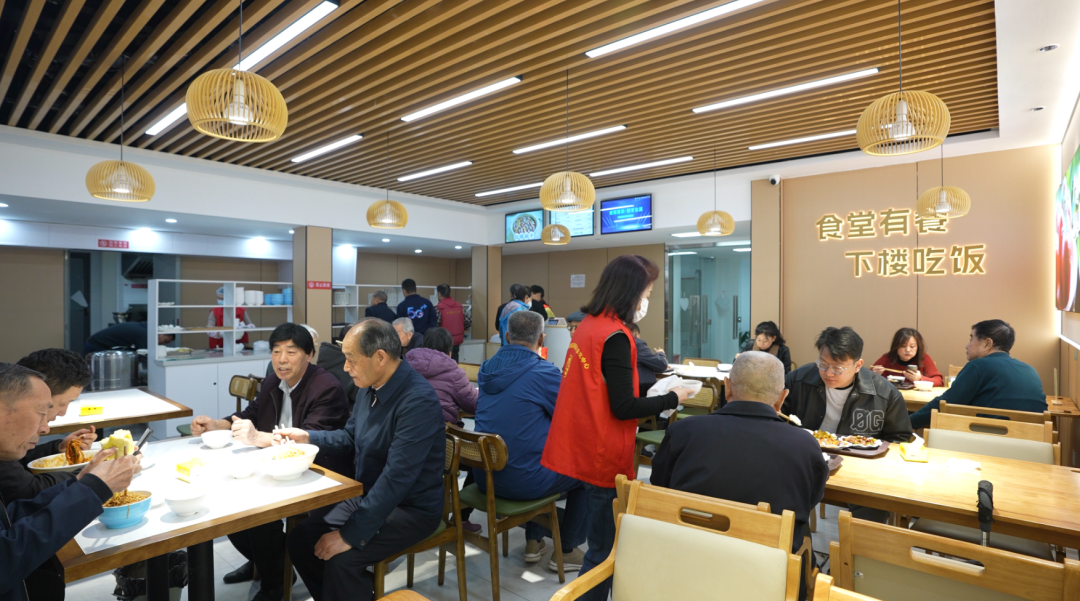
Recently, the Xi’an Municipal Government of Shaanxi Province issued the “Implementation Plan for the Construction of Embedded Service Facilities in Urban Communities” (hereinafter referred to as the “Implementation Plan”), which plans to complete 110 pilot projects and no less than 90 municipal projects over three years, using streets and communities as units, to promote the organic embedding of urban public service facilities into communities and extend the coverage of public service projects to better meet the people’s aspirations for a better life.
 Layout
Layout System Planning, Pilot Leading
System Planning, Pilot Leading
In February 2024, the main leaders of the Xi’an Civil Affairs Bureau led a team to visit and investigate communities, covering all 35 pilot communities planned for completion this year. “At each location, we not only looked at the current status of community service facilities and construction plans but also focused on understanding the construction pressures faced by the communities, helping them devise strategies and solve practical problems,” said Wang Weimin, a first-level researcher at the Xi’an Civil Affairs Bureau.
According to the requirements of the “Implementation Plan”, various districts and counties in Xi’an organized surveys on the construction of embedded service facilities in communities by street units, fully grasping the community housing, existing service conditions, and residents’ urgent needs, forming a “Basic Situation of Urban and Rural Community Service Facility Construction”, and completing the demand list for embedded service facilities in communities by the end of March.
During the project promotion process, a special working group for the construction of embedded service facilities in communities was established at both the municipal and district levels to coordinate relevant work, establishing an organizational coordination mechanism of “municipal guidance, district and county implementation, and full participation of streets and communities”, formulating a directory of national pilot projects and municipal projects, and implementing dynamic management. The office of the municipal working group is located in the Civil Affairs Bureau, with member units including the Municipal Development and Reform Commission, Municipal Housing and Urban-Rural Development Bureau, Municipal Resource Planning Bureau, and Municipal Health Commission, among others. On April 3, the first meeting of the office directors of the municipal working group was held, proposing to strengthen information sharing and cooperation, and to fulfill guidance and assessment responsibilities.
As the leading unit, the Xi’an Civil Affairs Bureau formulated the “Management Measures for the Construction and Operation of Embedded Service Facilities in Communities (Trial)” and other documents to guide and supervise various districts and counties in completing community elderly care services and community meal assistance facility construction tasks, issuing reward and subsidy measures for the operation of community elderly care services and community meal assistance facilities, and ensuring their implementation, while strengthening operation and supervision.
 Construction
Construction Adapt to local conditions, continue to promote
Adapt to local conditions, continue to promote

During breakfast and lunch hours, elderly people flock to the community cafeteria in Shangpu Community on Xinyu Road in the New District. Mr. Li, a resident, has been coming to eat since the community cafeteria opened in December last year, praising the food here: “Convenient, affordable, and good variety.” This community cafeteria is a community elderly care meal assistance project promoted by the New District Civil Affairs Bureau, adopting a model of “government guidance + socialized operation” to provide dining convenience for elderly people in need of meal assistance, while disabled individuals, sanitation workers, and active and retired military personnel can also apply for care cards to enjoy cafeteria services.
According to Li Jingjun, the secretary of the Shangpu Community Party Committee, the community is located in the center of Xi’an, with a large elderly population but limited housing and services. To solve the space issue, the New District Civil Affairs Bureau and the Xinyu Road Street Office actively coordinated with the provincial government affairs service center in the area to provide idle housing and vacant land for the Shangpu Community to carry out meal assistance and other services.
The “Implementation Plan” proposes that each district and county, using streets or communities as units, actively revitalize existing resources and expand space. According to the requirements of functionality expansion, space conversion, and compatibility of standards, construction plans should be reasonably formulated using new construction, reconstruction, expansion, and supplementary construction methods, achieving “one community, one policy”. Priority should be given to community embedded service complexes with integrated functional layouts and included in the pilot program, while communities that do not currently meet the conditions may consider decentralized layouts of relatively singular service facilities.
 Operation
Operation Diverse participation, public welfare and benefit
Diverse participation, public welfare and benefit
How to avoid the situation where the construction of embedded service facilities in communities is grand but the services are cold? “Public satisfaction is a measure of the effectiveness of construction and operation. The project is demand-oriented, providing precise services and operating in a universal manner, ensuring that construction is fast, effective, and of high quality,” said Wang Weimin. “The key to the construction of embedded service facilities in communities is to see whether the services provided truly meet the needs of the public. For example, during a survey in the Xincheng District’s Xinjia Miao Street’s Xizhong Community, it was found that the elderly population was relatively large, with several centenarians, while there were only 23 children aged 0 to 3, indicating low demand for infant care. Therefore, we adjusted the construction plan for this community to optimize elderly care and meal assistance services.”
“Close to home”, “low price”, “good service”… are the residents’ requirements for embedded service facilities in communities. Can universal operation achieve sustainable development? According to the “Management Measures for the Construction and Operation of Embedded Service Facilities in Communities (Trial)”, comprehensive standardization of the operation management of embedded service facilities in communities is required. Based on residents’ needs, market supply, and fiscal capacity, scientifically select construction and operation models such as public construction and private operation, private construction and public assistance, and government purchase of services.
“We have a principle that the buildings providing community services cannot be rented; they must ensure long-term operation and affordable prices,” Wang Weimin explained. Xi’an City revitalizes spatial resources according to the principle of “government-led construction, enterprises or social organizations as the main operators”, providing them to operating entities at no cost or low cost to help reduce operational costs. It explores chain and entrusted operation models for community embedded services, building a comprehensive service system of “street – community – neighborhood”. Following an integrated approach of “design – construction – operation”, it promotes the formation of a new model of community embedded services that is affordable and of high quality. It explores a method of “government subsidy, enterprise concession, community assistance, individual payment” to provide universal and professional services for residents, creating a sustainable development path of “policy brings benefits, enterprises have small profits, and the public receives welfare”. At the same time, it establishes an evaluation and feedback mechanism for the operation of community embedded services, exploring the establishment of a list of “qualified community service operators” to be publicly announced to strengthen supervision.
The construction of embedded service facilities in urban communities is one of the 30 key livelihood projects that Xi’an City aims to accomplish this year. Enjoying high-quality and universal public services at one’s doorstep is not only a “key small matter” but also a “big matter of people’s livelihood”. It is reported that Xi’an City will focus on the actual needs of community residents, guided by practicality and accessibility, increase the effective supply of community services, fill the gaps in facilities, innovate operational models, and create a number of well-equipped, safe, healthy, and orderly community embedded service models, striving to make communities a happy home for the people.
Source: China Social News, WeChat Public Account of China Community Work Network Reporter: Zhou Ranran


Source: Rural China